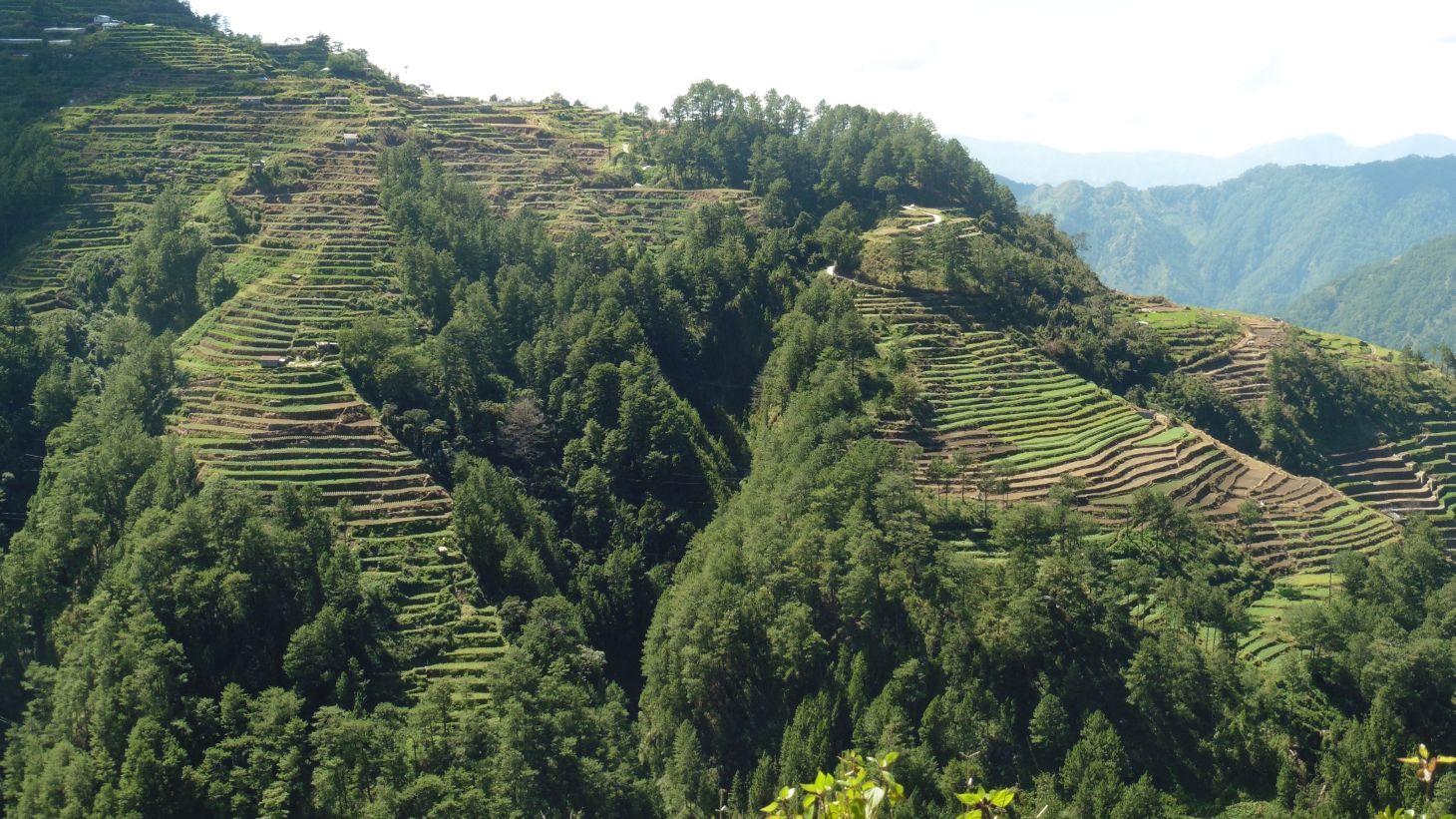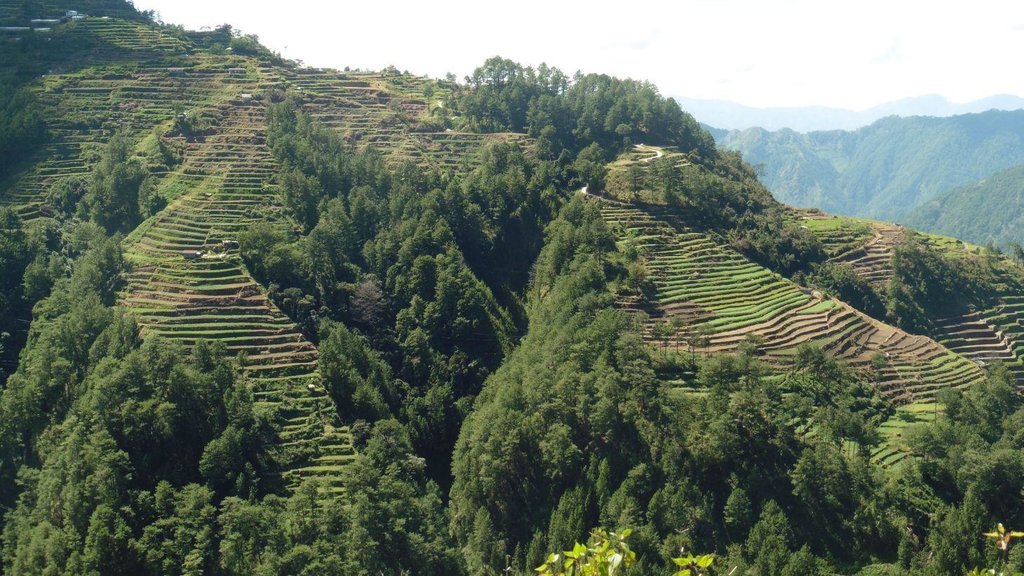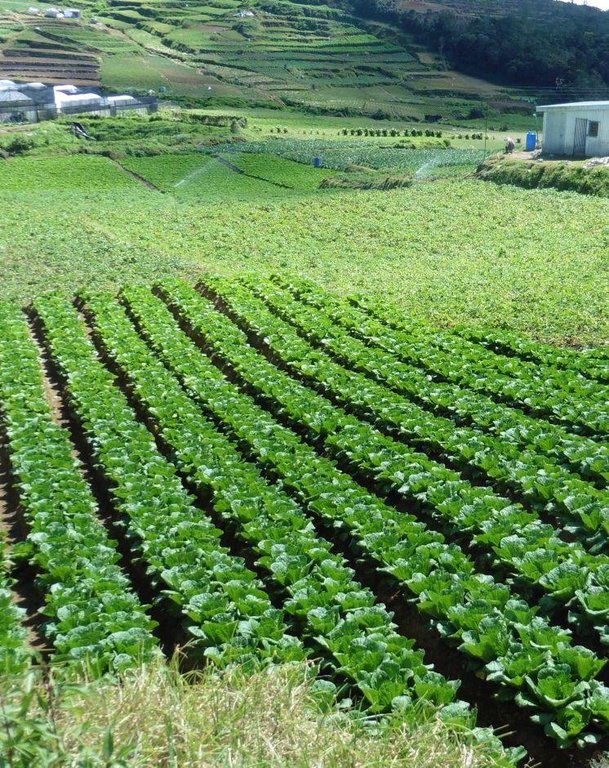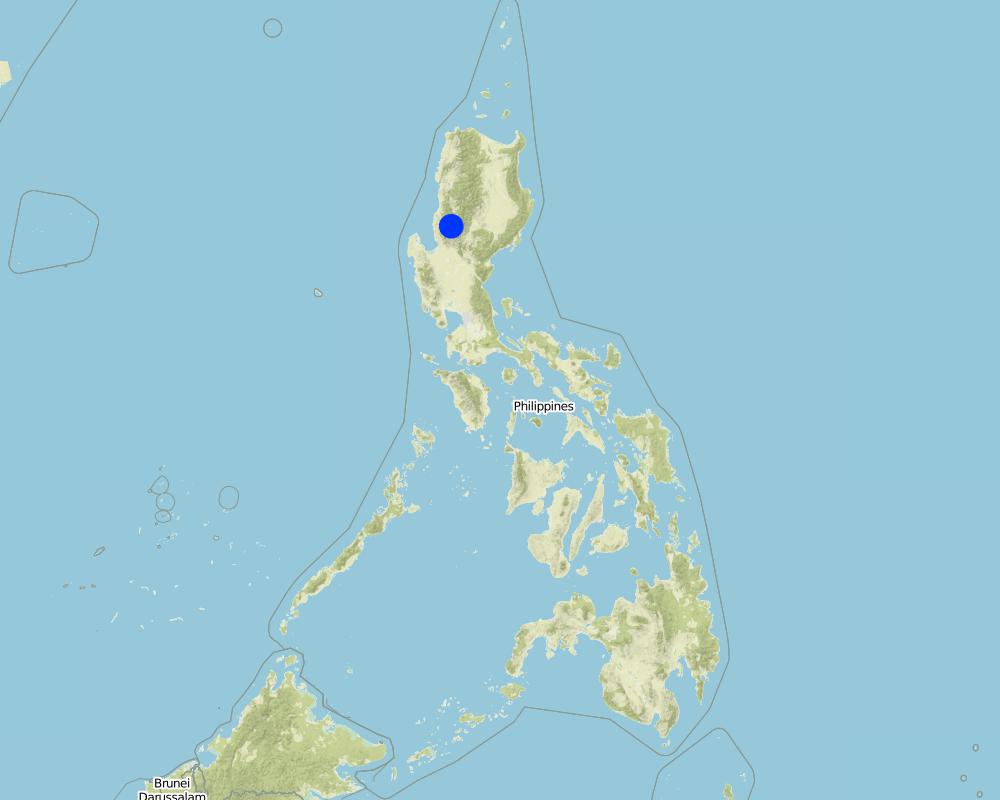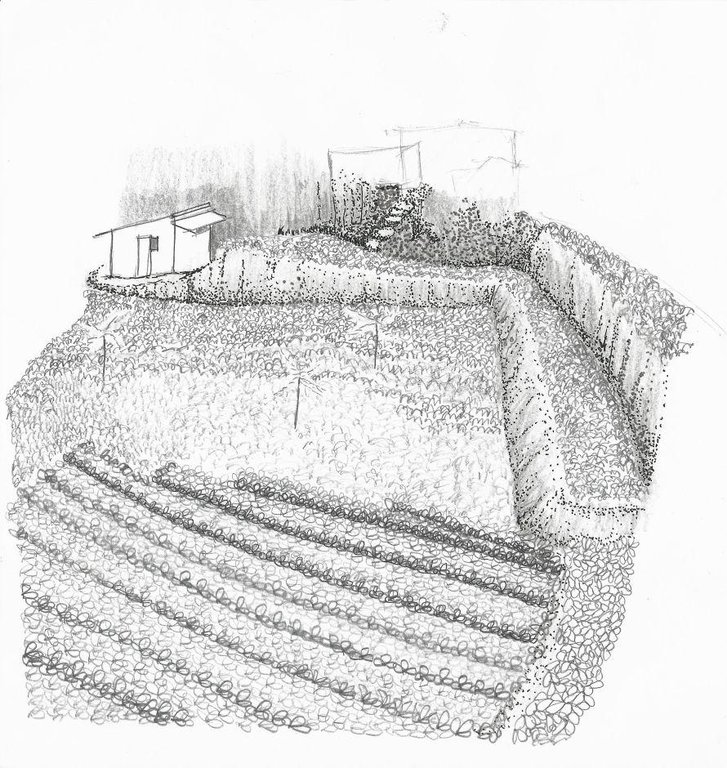Vegetable Terracing [Philippines]
- Creation:
- Update:
- Compiler: Philippine Overview of Conservation Approaches and Technologies
- Editor: –
- Reviewers: David Streiff, Alexandra Gavilano
technologies_1289 - Philippines
View sections
Expand all Collapse all1. General information
1.2 Contact details of resource persons and institutions involved in the assessment and documentation of the Technology
Name of the institution(s) which facilitated the documentation/ evaluation of the Technology (if relevant)
Department of Agriculture-Region VIII (DA-8) - PhilippinesName of the institution(s) which facilitated the documentation/ evaluation of the Technology (if relevant)
Benguet State University (Benguet State University) - Philippines1.3 Conditions regarding the use of data documented through WOCAT
The compiler and key resource person(s) accept the conditions regarding the use of data documented through WOCAT:
Ja
2. Description of the SLM Technology
2.1 Short description of the Technology
Definition of the Technology:
Vegetable terracing is a technology practiced at which point terraces are established from the contours along mountain slope for crop production.
2.2 Detailed description of the Technology
Description:
Vegetables are mostly produced in the mountains of the Cordillera Administrative Region (CAR). It is extensively practiced in the Municipalities of Atok, Buguias, Mankayan, Kibungan, Bakun, Kabayan in Benguet; Bauko in Mountain Province and Tinoc in Ifugao. Benguet is known as the "Salad Bowl of the Philippines" and major producer of temperate vegetables. This is mainly due to the climatic condition of the province which is suitable for vegetable production.Vegetable industry in Benguet is very vital in the country since it supplies 60-70% of the total sub-tropical vegetables in the Philippines. Major vegetable crops grown are potato, cabbage, chinese cabbage, carrots, chayote, beans, lettuce and broccoli. These are sold to traders, consolidators, wholesalers who transport the produce at the La Trinidad Vegetable Trading Post or other local markets in the region.
Purpose of the Technology: Available arable lands are not expanding but the population is increasing. This situation contributes to the conversion of sloping areas to a suitable land for agricultural production,thus, the technology was developed. This had become an economic practicality to the land user as source of livelihood and income. Vegetable terracing is also a conservation measure to minimize soil degradation by varying the terrace type and plot orientation. Some follow the contour while other plots are parallel to the slopes.
Establishment / maintenance activities and inputs: Prior to terrace establishment, vegetation is partly removed. Residues are cleared for the establishment of the contour lines of the area. From the established contour lines, terraces will be graded and leveled depending on the slope of the area. Most of these activities are done manually. After the establishment of the terraces, land preparation is done followed by planting of the vegetables.
Natural / human environment: The area is under humid agro-climate condition with an average annual rainfall of approximately 1000-1500 mm per year. Its elevation ranges from 2000-2500 meter above sea level. Majority of the population is dependent on agricultural activities as their source of income and livelihood. The average farm size of the land users ranges from 0.5 to 1 hectare. Most of these lands are not owned by the farmers but have a tax declaration. These are owned by the government classified as forest reservations or watershed areas.
2.3 Photos of the Technology
2.5 Country/ region/ locations where the Technology has been applied and which are covered by this assessment
Country:
Philippines
Region/ State/ Province:
Atok and Buguias
Further specification of location:
Benguet
Specify the spread of the Technology:
- evenly spread over an area
If precise area is not known, indicate approximate area covered:
- 0.1-1 km2
Comments:
This technology is widely practiced in the municipalities of Benguet.
Map
×2.6 Date of implementation
If precise year is not known, indicate approximate date:
- more than 50 years ago (traditional)
2.7 Introduction of the Technology
Specify how the Technology was introduced:
- as part of a traditional system (> 50 years)
Comments (type of project, etc.):
The technology was inherited from ancestors who started it during 1960's.
3. Classification of the SLM Technology
3.1 Main purpose(s) of the Technology
- improve production
- reduce, prevent, restore land degradation
3.2 Current land use type(s) where the Technology is applied

Cropland
- Annual cropping
Annual cropping - Specify crops:
- root/tuber crops - potatoes
- vegetables - leafy vegetables (salads, cabbage, spinach, other)
- vegetables - root vegetables (carrots, onions, beet, other)
Number of growing seasons per year:
- 2
Comments:
Major cash crop: cabbage, carrot, potato
Major land use problems (compiler’s opinion): low productivity, intensive land cultivation
Major land use problems (land users’ perception): Soil erosion, decreased soil fertility and excessive chemical inputs
Future (final) land use (after implementation of SLM Technology): Cropland: Ca: Annual cropping
3.3 Has land use changed due to the implementation of the Technology?
Has land use changed due to the implementation of the Technology?
- Yes (Please fill out the questions below with regard to the land use before implementation of the Technology)

Forest/ woodlands
- (Semi-)natural forests/ woodlands
Comments:
Forests / woodlands: Fn: Natural
3.4 Water supply
Water supply for the land on which the Technology is applied:
- rainfed
3.5 SLM group to which the Technology belongs
- cross-slope measure
3.6 SLM measures comprising the Technology

agronomic measures
- A1: Vegetation/ soil cover

structural measures
- S1: Terraces
Comments:
Main measures: agronomic measures, structural measures
Type of agronomic measures: contour planting / strip cropping
3.7 Main types of land degradation addressed by the Technology

soil erosion by water
- Wt: loss of topsoil/ surface erosion

chemical soil deterioration
- Cn: fertility decline and reduced organic matter content (not caused by erosion)
Comments:
Main type of degradation addressed: Wt: loss of topsoil / surface erosion, Cn: fertility decline and reduced organic matter content
Main causes of degradation: soil management (Excessive chemical inputs)
3.8 Prevention, reduction, or restoration of land degradation
Specify the goal of the Technology with regard to land degradation:
- reduce land degradation
Comments:
Main goals: mitigation / reduction of land degradation
4. Technical specifications, implementation activities, inputs, and costs
4.1 Technical drawing of the Technology
Technical specifications (related to technical drawing):
Vegetables planted in raised beds.
Location: Buguias. Benguet
Date: 11-13-15
Technical knowledge required for field staff / advisors: moderate
Technical knowledge required for land users: moderate
Main technical functions: control of dispersed runoff: impede / retard, control of concentrated runoff: impede / retard, reduction of slope angle
Contour planting / strip cropping
Material/ species: Cabbage
Quantity/ density: 40 tons/ha
Agronomic measure: contour planting / strip cropping
Material/ species: Carrots
Quantity/ density: 20 tons/ha
Agronomic measure: contour planting / strip cropping
Material/ species: Potato
Quantity/ density: 20 tons/ha
Structural measure: terrace: forward sloping (earth and stone)
Author:
Mr. Patricio A. Yambot, Bureau of Soils and Water Management
4.2 General information regarding the calculation of inputs and costs
Specify currency used for cost calculations:
- USD
Indicate average wage cost of hired labour per day:
3.33333
4.3 Establishment activities
| Activity | Timing (season) | |
|---|---|---|
| 1. | Establishment of terraces |
4.4 Costs and inputs needed for establishment
| Specify input | Unit | Quantity | Costs per Unit | Total costs per input | % of costs borne by land users | |
|---|---|---|---|---|---|---|
| Labour | Building terraces | Persons/day | 120.0 | 4.44166666 | 533.0 | 100.0 |
| Equipment | tools | pieces | 2.0 | 6.666666 | 13.33 | 100.0 |
| Total costs for establishment of the Technology | 546.33 | |||||
| Total costs for establishment of the Technology in USD | 546.33 | |||||
Comments:
Duration of establishment phase: 6 month(s)
4.5 Maintenance/ recurrent activities
| Activity | Timing/ frequency | |
|---|---|---|
| 1. | Land Preparation | |
| 2. | Application of chicken manure | |
| 3. | Planting | |
| 4. | Side raising including application of fertilizer | |
| 5. | Weeding | |
| 6. | Spraying of insecticide | |
| 7. | Harvesting |
4.6 Costs and inputs needed for maintenance/ recurrent activities (per year)
| Specify input | Unit | Quantity | Costs per Unit | Total costs per input | % of costs borne by land users | |
|---|---|---|---|---|---|---|
| Labour | Land preparation | Persons/day | 30.0 | 3.3333333 | 100.0 | 100.0 |
| Labour | Planting | Persons/day | 15.0 | 3.333333 | 50.0 | 100.0 |
| Labour | Applying Fertilizer and sprying insecticide | Persons/day | 31.0 | 3.333333 | 103.33 | 100.0 |
| Labour | Weeding/Harvesting | Persons/day | 18.0 | 3.333333 | 60.0 | 100.0 |
| Plant material | seeds | ha | 1.0 | 11.11 | 11.11 | 100.0 |
| Fertilizers and biocides | Inseciticides | litres | 2.5 | 13.156 | 32.89 | 100.0 |
| Fertilizers and biocides | Fertilizer | bags | 7.0 | 26.66714 | 186.67 | 100.0 |
| Fertilizers and biocides | Chicken manure | bags | 15.0 | 5.5553333 | 83.33 | 100.0 |
| Total costs for maintenance of the Technology | 627.33 | |||||
| Total costs for maintenance of the Technology in USD | 627.33 | |||||
5. Natural and human environment
5.1 Climate
Annual rainfall
- < 250 mm
- 251-500 mm
- 501-750 mm
- 751-1,000 mm
- 1,001-1,500 mm
- 1,501-2,000 mm
- 2,001-3,000 mm
- 3,001-4,000 mm
- > 4,000 mm
Agro-climatic zone
- humid
Thermal climate class: tropics
5.2 Topography
Slopes on average:
- flat (0-2%)
- gentle (3-5%)
- moderate (6-10%)
- rolling (11-15%)
- hilly (16-30%)
- steep (31-60%)
- very steep (>60%)
Landforms:
- plateau/plains
- ridges
- mountain slopes
- hill slopes
- footslopes
- valley floors
Altitudinal zone:
- 0-100 m a.s.l.
- 101-500 m a.s.l.
- 501-1,000 m a.s.l.
- 1,001-1,500 m a.s.l.
- 1,501-2,000 m a.s.l.
- 2,001-2,500 m a.s.l.
- 2,501-3,000 m a.s.l.
- 3,001-4,000 m a.s.l.
- > 4,000 m a.s.l.
Comments and further specifications on topography:
Altitudinal zone: 2375 m a.s.l.
5.3 Soils
Soil depth on average:
- very shallow (0-20 cm)
- shallow (21-50 cm)
- moderately deep (51-80 cm)
- deep (81-120 cm)
- very deep (> 120 cm)
Soil texture (topsoil):
- medium (loamy, silty)
Topsoil organic matter:
- low (<1%)
If available, attach full soil description or specify the available information, e.g. soil type, soil PH/ acidity, Cation Exchange Capacity, nitrogen, salinity etc.
Soil fertility low: Needs high fertilizer input
Soil drainage / infiltration: Medium
Soil water storage capacity: Medium
5.4 Water availability and quality
Availability of surface water:
medium
Water quality (untreated):
good drinking water
Comments and further specifications on water quality and quantity:
Availability of surface water: from river pumped in the farm through gravity
5.5 Biodiversity
Species diversity:
- medium
5.6 Characteristics of land users applying the Technology
Market orientation of production system:
- commercial/ market
Off-farm income:
- less than 10% of all income
Relative level of wealth:
- average
Individuals or groups:
- individual/ household
Level of mechanization:
- manual work
Gender:
- women
- men
Indicate other relevant characteristics of the land users:
Land users applying the Technology are mainly common / average land users
Population density: 10-50 persons/km2
Annual population growth: 1% - 2%; 2%
60% of the land users are average wealthy and own 60% of the land.
Market orientation of production system: Products were delivered to the La Trinidad trading post
5.7 Average area of land used by land users applying the Technology
- < 0.5 ha
- 0.5-1 ha
- 1-2 ha
- 2-5 ha
- 5-15 ha
- 15-50 ha
- 50-100 ha
- 100-500 ha
- 500-1,000 ha
- 1,000-10,000 ha
- > 10,000 ha
Is this considered small-, medium- or large-scale (referring to local context)?
- small-scale
Comments:
Average area of land owned or leased by land users applying the Technology: Also 1-2 ha
5.8 Land ownership, land use rights, and water use rights
Land ownership:
- individual, titled
Land use rights:
- individual
Water use rights:
- open access (unorganized)
5.9 Access to services and infrastructure
health:
- poor
- moderate
- good
education:
- poor
- moderate
- good
technical assistance:
- poor
- moderate
- good
employment (e.g. off-farm):
- poor
- moderate
- good
markets:
- poor
- moderate
- good
energy:
- poor
- moderate
- good
roads and transport:
- poor
- moderate
- good
drinking water and sanitation:
- poor
- moderate
- good
6. Impacts and concluding statements
6.1 On-site impacts the Technology has shown
Socio-economic impacts
Production
risk of production failure
production area
Income and costs
diversity of income sources
Socio-cultural impacts
food security/ self-sufficiency
recreational opportunities
community institutions
Livelihoods and human well-beeing
Ecological impacts
Water cycle/ runoff
surface runoff
Soil
soil loss
Biodiversity: vegetation, animals
Vegetation cover
Comments/ specify:
Natural vegetation such as forest is partially reduced for vegetable production
6.2 Off-site impacts the Technology has shown
downstream flooding
buffering/ filtering capacity
6.3 Exposure and sensitivity of the Technology to gradual climate change and climate-related extremes/ disasters (as perceived by land users)
Climate-related extremes (disasters)
Meteorological disasters
| How does the Technology cope with it? | |
|---|---|
| local rainstorm | not well |
Hydrological disasters
| How does the Technology cope with it? | |
|---|---|
| general (river) flood | not well |
6.4 Cost-benefit analysis
How do the benefits compare with the establishment costs (from land users’ perspective)?
Short-term returns:
slightly positive
Long-term returns:
slightly positive
How do the benefits compare with the maintenance/ recurrent costs (from land users' perspective)?
Short-term returns:
neutral/ balanced
Long-term returns:
neutral/ balanced
6.5 Adoption of the Technology
If available, quantify (no. of households and/ or area covered):
NA
Of all those who have adopted the Technology, how many did so spontaneously, i.e. without receiving any material incentives/ payments?
- 91-100%
Comments:
100% of land user families have adopted the Technology without any external material support
There is a little trend towards spontaneous adoption of the Technology
6.7 Strengths/ advantages/ opportunities of the Technology
| Strengths/ advantages/ opportunities in the compiler’s or other key resource person’s view |
|---|
|
Source of livelihood for the land users in the mountainous area. How can they be sustained / enhanced? It should be balanced by relevant environmental protective measures and alternative farming systems such as agroforestry. |
|
Minimize soil erosion How can they be sustained / enhanced? Construction of Small Water Impounding System (SWIS) and proper drainage canal. |
6.8 Weaknesses/ disadvantages/ risks of the Technology and ways of overcoming them
| Weaknesses/ disadvantages/ risks in the compiler’s or other key resource person’s view | How can they be overcome? |
|---|---|
| Vegetation is partially removed for vegetable production. | Protection of remaining areas through regulations and implementations of related policies. |
7. References and links
7.1 Methods/ sources of information
Links and modules
Expand all Collapse allLinks
No links
Modules
No modules


